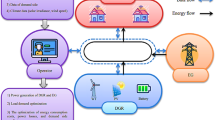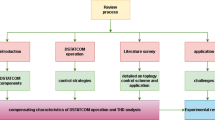Abstract
This paper presents a novel approach for harmonic responsibility assessment based on an optimization problem solved by safety barrier interior point method. In the proposed methodology, a power quality monitor is installed at the point of common coupling of a distribution system Norton equivalent circuit in order to measure voltage and current phasors continuously obtained from the network in regular time intervals. In order to determine customer and utility contributions, a state variables vector is formed by harmonic currents and impedances from both sides being modeled in rectangular coordinates. The objective function to be minimized is the sum of the quadratic differences between measured current and voltage phasors and their corresponding values calculated as function of the state variables. Uncertainties associated with the network impedances are handled as inequality constraints of the optimization model. Based on superposition principle, indices are proposed for determining harmonic responsibility sharing based on the estimated variables. Results are validated by different case studies considering the effect of measurement accuracy, uncertain parameters and number of samples used for the estimation process.











Similar content being viewed by others

References
Adak S, Cangi H, Eid B, Yilmaz AS (2021) Developed analytical expression for current harmonic distortion of the pv system’s inverter in relation to the solar irradiance and temperature. Electr Eng 103(1):697–704
Kapoor R, Verma S, Kapoor A (2021) Quaternions-based detection of power quality events. Electr Eng 2021:1–17
Melo ID, Pereira JL, Variz AM, Ribeiro PF (2020) Allocation and sizing of single tuned passive filters in three-phase distribution systems for power quality improvement. Electr Power Syst Res 180:106128
Melo ID, Pereira JL, Ribeiro PF, Variz AM, Oliveira BC (2019) Harmonic state estimation for distribution systems based on optimization models considering daily load profiles. Electr Power Syst Res 170:303–316
Melo ID, Pereira JL, Variz AM, Garcia PA (2017) Harmonic state estimation for distribution networks using phasor measurement units. Electr Power Syst Res 147:133–144
Bečirović V, Pavić I, Filipović-Grčić B (2018) Sensitivity analysis of method for harmonic state estimation in the power system. Electr Power Syst Res 154:515–527
Moradifar A, Foroud AA, Firouzjah KG (2017) Intelligent localisation of multiple non-linear loads considering impact of harmonic state estimation accuracy. IET Gener Transm Distrib 11(8):1943–1953
Carta A, Locci N, Muscas C (2009) A pmu for the measurement of synchronized harmonic phasors in three-phase distribution networks. IEEE Trans Instrum Meas 58(10):3723–3730
Granados-Lieberman D (2020) Global harmonic parameters for estimation of power quality indices: an approach for pmus. Energies 13(9):2337
Safargholi F, Malekian K, Schufft W (2017) On the dominant harmonic source identification-part i: review of methods. IEEE Trans Power Deliv 33(3):1268–1277
Safargholi F, Malekian K, Schufft W (2017) On the dominant harmonic source identification-part ii: application and interpretation of methods. IEEE Trans Power Deliv 33(3):1278–1287
Špelko A, Blažič B, Papič I, Pourarab M, Meyer J, Xu X, Djokic S (2017) Cigre/cired jwg c4. 42: overview of common methods for assessment of harmonic contribution from customer installation. In: 2017 IEEE Manchester PowerTech, IEEE, pp 1–6
Sinvula R, Abo-Al-Ez KM, Kahn MT (2019) Harmonic source detection methods: a systematic literature review. IEEE Access 7:74283–74299
Monteiro HL, Duque CA, Silva LR, Meyer J, Stiegler R, Testa A, Ribeiro PF (2017) Harmonic impedance measurement based on short time current injections. Electr Power Syst Res 148:108–116
dos Santos AC, Santos IN, de Oliveira JC (2019) Capacitor switching methodology for responsibility sharing of harmonic voltage distortions. Int Trans Electr Energy Syst 29(12):e12135
Xu W, Liu X, Liu Y (2003) An investigation on the validity of power-direction method for harmonic source determination. IEEE Trans Power Deliv 18(1):214–219
Dell’Aquila A, Marinelli M, Monopoli VG, Zanchetta P (2004) New power-quality assessment criteria for supply systems under unbalanced and nonsinusoidal conditions. IEEE Trans Power Deliv 19(3):1284–1290
Li C, Xu W, Tayjasanant T (2004) A critical impedance-based method for identifying harmonic sources. IEEE Trans Power Deliv 19(2):671–678
Moradifar A, Foroud AA, Firouzjah KG (2019) Comprehensive identification of multiple harmonic sources using fuzzy logic and adjusted probabilistic neural network. Neural Comput Appl 31(1):543–556
Lin R, Xu L, Zheng X (2018) A method for harmonic sources detection based on harmonic distortion power rate. In: IOP conference series: materials science and engineering, vol 322, IOP Publishing, p 072038 (2018)
Oliveira EJ, Oliveira LW, Pereira J, Honório LM, Junior ICS, Marcato A (2015) An optimal power flow based on safety barrier interior point method. Int J Electr Power Energy Syst 64:977–985
Burch R, Chang G-K, Hatziadoniu C, Grady M, Liu Y, Marz M, Ortmeyer T, Ranade S, Ribeiro P, Xu W (2003) Impact of aggregate linear load modeling on harmonic analysis: a comparison of common practice and analytical models. IEEE Trans Power Deliv 18(2):625–630
PE Society (2003) Tutorial on harmonics modeling and simulation. In: Proceedings of IEEE power Engineering Society, Winter meeting
Grid A (2014) Reason/ge rpv311 digital fault recorder with pmu and twfl technical manual
Author information
Authors and Affiliations
Corresponding author
Additional information
Publisher's Note
Springer Nature remains neutral with regard to jurisdictional claims in published maps and institutional affiliations.
Appendix A: Safety barrier interior point method
Appendix A: Safety barrier interior point method
Generally, the optimization problem can be formulated as Eq. (41):
where \(x^h\) is the state variables vector for a given harmonic order h, J is the objective function, \(e(x^h)\) represents equality constraints and l and u are lower and upper bounds of the inequality constraints, respectively. The inequality constraints are transformed to equality constraints by introducing slack variables \(s_{l}\) and \(s_{u}\) as described by equations (42):
where \(s_{l}\) and \(s_{u}\) are slack variables associated with lower and upper limits. The constraints are eliminated by adding a logarithmic barrier function to the objective function as in (43). It means that variables \(s_{l}\) and \(s_{u}\) must be greater than zero and inequality constraints can never assume values on the border.
where n is the number of inequality constraints of the problem. Initially, the barrier parameter (\(\mu \)) assumes a value greater than zero, and at the end of the iterative process, it must be near to zero. The Safety barrier Interior Point method introduces the new safety barrier parameter \(\rho \) in (44). Its value is always positive and is initially user defined. Then, the new optimization problem can be written as:
In the formulation, \(\rho \) ensures the elimination of the barrier proximity problems and the constraints allows the slack variables \(s_{l}\) and \(s_{u}\) to assume zero values. The state variables can assume the exact limit values (l or u) to find the optimal solution. Then, the Lagrangian function can be defined as the following expression (45):
where m is the number of equality constraints, Lagrange multipliers vector associated with the equality constraints are \(\lambda \), and \(\pi _{l}\) and \(\pi _{u}\) are Lagrange multipliers vectors associated with the lower and upper bound variables, and can be calculated as (46):
The first-order optimality conditions for the optimization problem associated with the Newton–Raphson method result in (47):
where
The Hessian matrix (\(H_{x^h}\)) as well as to the Gradient vector(\(H_{x^h}\)) are defined from Eqs. (48)–(51) in which \(\nabla \) and \(\nabla ^2\) are the partial derivative and the gradient of a given function, respectively. From the solution of the system, \(\Delta x^h\) and \(\Delta \lambda \) are obtained at each iteration of the process, while the search directions \(\Delta s_{l}, \Delta s_{u},\Delta \pi _{l,j},\Delta \pi _{u,j}\) are calculated from Eqs. (52–55)
The step length of the primal-dual variables is given by (56):
The variables are then updated for the next iteration (it.) according to (57):
The barrier parameter is updated, considering the duality gap (GAP), and the parameter \(\beta \) is introduced to control the decay of the barrier parameter to improve the convergence process as in (58).
The safety barrier parameter is also updated by a factor \(\tau \) as in Eq. (59), meaning that the value of the parameter is decreased for the next iteration of the algorithm.
The initial value of the barrier parameter (\(\mu =5\)) and minimum value (\(\mu =10^{-8}\)) are adopted. The average of the minimum and maximum values of \(x^h\) was set as the initial value of the primal variables, \(x^h_o\). The slack variables \(s_{l}\) and \(s_{u}\) are calculated from \(x^h_o-s_{l}=l\) and \(x^h_o-s_{u}=u\) for the process initialization. Lagrange multipliers \(\lambda \) are initially set to one, and initial values of the dual variables \(\pi _{l,j}\) and \(\pi _{u,j}\) are calculated from equations.
The safety barrier (\(\rho \)) parameter has initial value of \(10^{-2}\) and minimum value of \(10^{-10}\). Values for \(\tau \) and \(\beta \) are 0.3 and 0.5, respectively. The convergence criteria adopted is \(\mu =10^{-5}\), and the optimization algorithm stops when the change in the state variables vector is less than a tolerance of \(10^{-6}\).
Rights and permissions
About this article
Cite this article
Melo, I.D., Antunes, M.P. A novel approach for harmonic responsibility assessment based on an optimization model. Electr Eng 104, 2923–2934 (2022). https://doi.org/10.1007/s00202-022-01520-9
Received:
Accepted:
Published:
Issue Date:
DOI: https://doi.org/10.1007/s00202-022-01520-9



